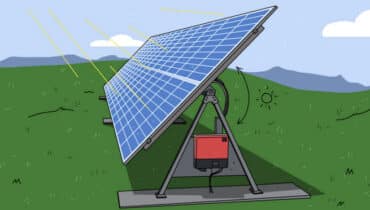Table of Contents
In a world increasingly concerned about environmental sustainability, the choice of renewable energy sources has become more critical than ever. Among the most popular options are wind turbines and solar panels. Both technologies harness energy from the environment, reduce carbon footprints, and offer long-term economic benefits. However, choosing between them can be a daunting task. This article will guide you through the differences, advantages, and disadvantages of wind turbines and solar panels, helping you make an informed decision.
As the world shifts towards sustainable energy solutions, the choice between wind turbines and solar panels has become pivotal. Let’s compare these renewable energy products to help you select the best fit for your needs.
Wind Turbines: Power from the Wind
Wind turbines are tall structures with rotating blades that convert wind energy into electricity. They come in various models, but here are some of the top products available:
1. Siemens Gamesa SG 5.8-155
- The Siemens Gamesa SG 5.8-155 is a giant among wind turbines.
- With a capacity of 5.8 MW, it can power thousands of homes.
- It features advanced technology for increased energy capture and grid reliability.
2. Vestas V164-10.0 MW
- The Vestas V164-10.0 MW is a powerful offshore wind turbine.
- With a colossal 10 MW capacity.
- it’s designed for offshore wind farms and can handle extreme weather conditions.
3. GE Haliade-X 12 MW
- GE’s Haliade-X 12 MW is one of the largest and most powerful wind turbines globally.
- Designed for both offshore and onshore installations.
- Its cutting-edge design maximizes energy production.
Solar Panels: Capturing Sunlight
Solar panels convert sunlight into electricity through photovoltaic cells. Here are some of the best solar panel products available:
4. SunPower X-Series
- SunPower’s X-Series solar panels are renowned for their efficiency and durability.
- They offer high energy production and are known for their sleek, all-black design.
5. LG NeON 2
- LG’s NeON 2 series features high-efficiency solar panels with improved performance in low-light conditions.
- They are known for their aesthetics and reliability.
6. Tesla Solar Roof
- Tesla’s Solar Roof is a unique product that integrates solar cells into roof shingles.
- It’s a game-changer for residential solar installations, offering both energy production and roof protection.
Factors to Consider
When choosing between wind turbines and solar panels, consider factors such as your location, energy needs, available space, budget, and maintenance requirements. These factors will help you determine which product is the best fit for your renewable energy goals.
In this topic, both wind turbines and solar panels have their advantages, and the best product for you depends on your specific circumstances and priorities. Whether you opt for the high-energy efficiency of wind turbines or the versatility of solar panels, both options contribute to a greener, more sustainable future.
Wind Turbines: Harnessing the Power of the Wind
Wind turbines are awe-inspiring structures designed to capture the kinetic energy of the wind and convert it into electricity. They play a pivotal role in the world’s transition to cleaner and more sustainable energy sources. Here’s a closer look at how wind turbines work and their significance in the renewable energy landscape.
The Anatomy of a Wind Turbine
Wind turbines consist of several key components, each with a specific role in generating electricity:
- Rotor Blades: The most iconic feature of a wind turbine, the rotor blades, captures the kinetic energy of the wind. These blades are carefully designed to maximize efficiency and generate as much power as possible.
- Nacelle: Located atop a tall tower, the nacelle houses critical components, including the gearbox, generator, and control systems. It serves as the “brain” of the wind turbine, managing its operations.
- Tower: The tower’s height is essential to position the rotor blades at a suitable altitude where wind speeds are higher and more consistent. Taller towers result in more efficient energy generation.
- Gearbox: The gearbox is responsible for increasing the rotational speed of the rotor blades to a level that can generate electricity effectively.
- Generator: Once the rotor blades turn, the generator converts the mechanical energy into electrical energy, which is then transmitted for use or storage.
How Wind Turbines Work
The operation of a wind turbine can be broken down into a few simple steps:
- Wind Capture: As the wind blows, it flows over and around the rotor blades. The design of the blades allows them to capture the kinetic energy from the wind.
- Rotation: The captured wind energy causes the rotor blades to spin. The speed of rotation depends on the wind’s velocity.
- Mechanical Energy: The rotational motion of the blades is transferred to the gearbox, which increases the speed of rotation. This mechanical energy is then passed on to the generator.
- Electrical Generation: The generator converts the mechanical energy into electrical energy, creating a flow of electrons through a circuit. This electrical energy is then harnessed for various applications.
Significance of Wind Turbines
Wind turbines hold immense significance in the realm of renewable energy for several reasons:
- Clean and Sustainable: Wind turbines produce electricity without emitting harmful greenhouse gases or pollutants, making them an environmentally friendly energy source.
- Energy Independence: Wind energy reduces reliance on fossil fuels, contributing to energy security and independence for nations.
- Economic Benefits: Wind power creates jobs, stimulates local economies, and attracts investments in the renewable energy sector.
- Reduced Carbon Footprint: Wind turbines play a vital role in mitigating climate change by reducing carbon emissions from the energy sector.
- Scalability: Wind farms can range from small-scale, single-turbine installations to massive offshore wind farms, making wind energy adaptable to various needs.
In conclusion, wind turbines are remarkable machines that harness the power of the wind to generate clean and sustainable electricity. They play a pivotal role in our transition towards a more environmentally conscious and sustainable energy landscape. As technology continues to advance, wind turbines will become even more efficient and integral in meeting our energy needs while reducing our impact on the planet.
Solar Panels: Capturing Sunshine for Electricity
Solar panels, also known as photovoltaic panels, are a remarkable technology that converts the sun’s abundant energy into electricity. They consist of photovoltaic cells that work collectively to capture sunlight and transform it into a clean and sustainable power source. These panels are designed to be highly efficient, making them a popular choice for renewable energy generation.
The process begins when sunlight strikes the panels, causing the photovoltaic cells to release electrons, creating an electrical current. This energy can be used directly to power homes and businesses or stored in batteries for later use. Solar panels are versatile and can be installed on rooftops, in solar farms, and even integrated into building materials, revolutionizing the way we think about sustainable power.
Solar panels play a crucial role in reducing carbon emissions, combating climate change, and promoting energy independence. As technology advances, these panels become increasingly efficient and cost-effective, making solar power an essential component of our transition to a cleaner and more sustainable energy future.
Factors to Consider
When deciding between wind turbines and solar panels for your renewable energy needs, it’s crucial to weigh several key factors to make an informed choice.
Location
The choice between wind turbines and solar panels greatly depends on your geographical location. Wind turbines are more suitable for areas with consistent, strong winds, while solar panels thrive in sunnier regions.
Energy Needs
Consider your energy consumption. If you have high energy demands, a combination of both technologies may be the best solution. Wind turbines can supplement solar panels on windier days and vice versa.
Space
Evaluate the available space for your renewable energy setup. Wind turbines need more land, while solar panels can be integrated into existing structures, making them a great choice for urban environments.
Budget
Your budget plays a significant role in your choice. Wind turbines may require a larger upfront investment, while solar panels are often more cost-effective initially.
Maintenance
Both technologies require some level of maintenance. Wind turbines may require more frequent inspections due to their moving parts, while solar panels are generally low-maintenance.
FAQs
1. Which is more cost-effective, wind turbines or solar panels?
The cost-effectiveness of wind turbines versus solar panels depends on various factors, including your location, energy needs, and available resources. Generally, solar panels have a lower upfront cost and a shorter payback period, making them more cost-effective for many residential and commercial applications. However, wind turbines may be more cost-effective in areas with strong and consistent winds, where they can produce energy more efficiently.
2. Are wind turbines noisy?
Wind turbines do produce some noise due to the rotation of their blades and mechanical components. However, modern wind turbine designs prioritize reducing noise pollution. Their noise levels are generally comparable to common background noises, such as traffic or conversation. Proper placement and distance from residences can also mitigate any noise concerns.
3. How much space is needed for wind turbines and solar panels?
Wind turbines require more land or open space for proper spacing between units and to ensure that they capture wind effectively. The space needed for solar panels is relatively smaller, as they can be installed on rooftops, in open fields, or even integrated into building materials. The space requirements largely depend on the specific project’s scale and energy production goals.
4. Which technology is better for urban environments: wind turbines or solar panels?
Solar panels are generally a better fit for urban environments due to their smaller space requirements and minimal impact on the landscape. Rooftop solar installations, in particular, are well-suited for cities and urban areas. Wind turbines typically require more open space and are more commonly found in rural or suburban settings.
5. Can wind turbines and solar panels work together in a single system?
Yes, combining wind turbines and solar panels in a single renewable energy system is feasible and can provide a balanced and reliable energy source. This approach allows for energy generation during both windy and sunny conditions, ensuring a more consistent power supply. Such hybrid systems are increasingly popular for maximizing renewable energy production and improving energy resilience.
Conclusion
The choice between wind turbines and solar panels ultimately hinges on individual circumstances and objectives. Wind turbines are highly efficient and reliable in wind-rich regions, whereas solar panels offer versatility and cost-effectiveness, particularly in sunnier areas. Consider your location, energy needs, available space, budget, and maintenance capacity when making your decision.
Remember that both technologies contribute to a greener future, reducing carbon emissions and promoting sustainability. A hybrid approach may be the optimal choice, harnessing the strengths of wind and solar energy for a balanced, environmentally conscious energy solution.

